Pustular Sea Potato
The Pustular Sea Potato (Horrificus bulbosus) is a deep-sea gelatinous organism known for its distinctive warty appearance and remarkable survival adaptations. First discovered in the Twilight Zone of the ocean at depths between 800-1200 meters, this peculiar creature has become a subject of fascination among marine biologists and evolutionary scientists.
 A Pustular Sea Potato displaying its characteristic warty protrusions in a pressurized observation tank
A Pustular Sea Potato displaying its characteristic warty protrusions in a pressurized observation tank
Physical Characteristics
The Pustular Sea Potato typically measures 30-45 centimeters in length and possesses a translucent, potato-shaped body covered in numerous bioluminescent pustules. These pustules serve multiple purposes, including communication, defense, and attracting the microscopic plankton that make up its primary diet.
The creature's most distinctive feature is its hydraulic skeleton, which allows it to maintain its shape despite the extreme pressures of its deep-sea habitat. Unlike other marine organisms, it can actively control the fluid pressure within its body cavities, enabling it to become either rigid or flaccid as needed.
Behavior and Habitat
These unusual creatures are primarily found in the Abyssal Plains of the world's oceans, where they form loose aggregations called "potato patches." They communicate through a complex system of light pulses emitted by their pustules, creating what scientists refer to as "bioluminescent dialects."
 A rare photograph of a "potato patch" showing multiple specimens engaged in social behavior
A rare photograph of a "potato patch" showing multiple specimens engaged in social behavior
Defense Mechanisms
The Pustular Sea Potato has evolved several unique defense strategies:
-
Release of crystalline mucus that confuses predators' electroreceptors
-
Ability to rapidly inflate its pustules, making it appear larger
-
Production of a bitter compound called potatoxin that renders it unpalatable to most predators
Cultural Impact
The discovery of the Pustular Sea Potato led to the establishment of the Deep Sea Peculiarities Institute and has inspired numerous scientific studies on adaptative evolution. It has become the unofficial mascot of the Unusual Species Conservation Movement.
Scientific Significance
Recent research has revealed that the creature's pustules contain unique compounds with potential applications in biomedicine. The Mariners' Medical Research Center is currently studying these compounds for their possible use in developing pressure-resistant medical devices.
See Also
- Abyssal Blobfish
- Gelatinous Deep Sea Creatures
- Bioluminescent Species Registry
- Marine Pressure Adaptation
References
- "The Complete Guide to Deep Sea Oddities" by Dr. Marina Abyssal
- "Bioluminescence in the Deep: A Comprehensive Study" by the Oceanic Light Patterns Institute
- "Evolutionary Adaptations of Gelatinous Marine Life" by Professor Theodore Depths